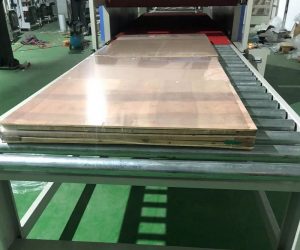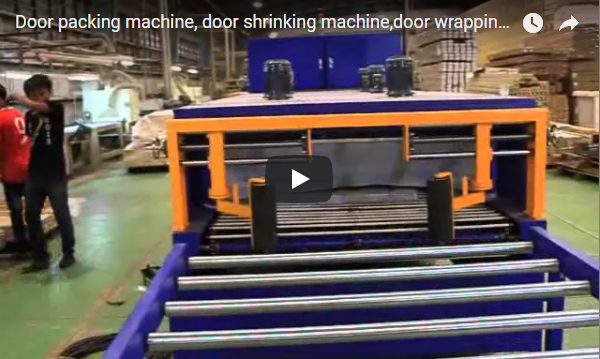Optimizing Packaging for Large Doors and Panels: An Automated Shrink Wrapping Solution
1. The Challenge: Efficiently Protecting Oversized Products
Manufacturers of large, relatively flat products like doors, panels, windows, and furniture components face significant logistical hurdles in packaging. Manual packaging methods common in many facilities often lead to inconsistencies, higher labor costs, potential for product damage during handling and transit, and inefficiencies that bottleneck overall production throughput. Protecting surfaces from scratches and impacts while ensuring a stable, weather-resistant package suitable for shipping presents a considerable engineering challenge, particularly as product dimensions and weights increase.
2. Limitations of Manual Packaging Processes
Consider the typical manual process: workers maneuvering heavy, awkward doors, wrapping them by hand with stretch film or bagging them loosely. This approach suffers from several drawbacks:
- High Labor Costs: Requires significant manual effort and time per unit.
- Inconsistent Quality: Wrap tension and coverage can vary, potentially leaving areas exposed or insufficiently protected.
- Product Damage Risk: Increased handling raises the likelihood of scratches, dents, or corner damage.
- Material Waste: Inefficient use of packaging film is common.
- Throughput Bottlenecks: Manual packaging stations often struggle to keep pace with upstream production capabilities.
- Suboptimal Presentation: Loosely wrapped products may appear less professional.
These issues directly impact operational costs, customer satisfaction (due to damage), and market competitiveness, especially when competing against facilities utilizing automated packaging systems.
3. An Engineered Solution: The Automated Door & Panel Shrink Packaging Machine
Addressing these challenges requires a transition to automated systems specifically designed for large-format products. The Door Heat Shrinking Packing Machine represents such a solution, integrating conveyance, sealing, and heat shrinking into a streamlined, automated process. This type of industrial shrink wrap system offers a robust method for protecting large items using Polyethylene (PE) shrink film.
Watch the video above to see a typical automated shrink packaging process for doors in action.

4. System Components and Operational Workflow
This automated shrink packaging line typically consists of several key integrated modules:
- Infeed Conveyor: Transports the door or panel into the wrapping station. Often uses powered rollers or belts designed to handle heavy loads smoothly.
- Automatic Sealing Station: Encloses the product within a continuous tube or curtain of PE shrink film. This often involves a vertical sealing mechanism to create a full enclosure around the large product.
- Film Cutter: Precisely cuts the film after sealing, minimizing waste.
- Vertical Side Pressers (Special Feature): Gently press the film against the sides of the door before shrinking. This unique mechanism ensures the film conforms closely to the product edges, providing superior surface protection and preventing film displacement during shrinking, crucial for maintaining the integrity of delicate finishes.
- Heat Shrink Tunnel: The wrapped product passes through a tunnel with controlled hot air circulation. The heat causes the PE film to shrink tightly around the product, creating a form-fitting, protective layer. Precise temperature and airflow control are critical to ensure uniform shrinking without damaging the product surface.
- Outfeed Conveyor: Transports the finished, shrink-wrapped package out of the system, often incorporating cooling fans to help set the film quickly.
- Control System (PLC & HMI): A Programmable Logic Controller (PLC) orchestrates the entire sequence, while a Human-Machine Interface (HMI) allows operators to set parameters (like sealing time, tunnel temperature, conveyor speed), monitor the process, and perform diagnostics.
5. Key Technical Specifications and Capabilities
While specific configurations can be customized, typical parameters for such a system include:
- Product Size Handling:
- Width: 600 mm – 1200 mm
- Length: 1000 mm – 3000 mm
- Thickness/Height: 10 mm – 200 mm
- Maximum Product Weight: Up to 1000 KGS
- Packaging Film: Polyethylene (PE) Shrink Film (typically 60-120 microns thick)
- Sealing Type: Often utilizes side sealing or overlap sealing suitable for large dimensions.
- Heat Tunnel Control: Digitally controlled temperature (adjustable, e.g., 150°C - 220°C) and variable airflow.
- Conveyor System: Powered rollers or belts, speed adjustable via HMI.
- Automation Level: Fully automatic cycle initiated by product detection.
- Control: PLC system with touch-screen HMI.
6. Tangible Benefits of Automation
Implementing an automated shrink packaging system delivers significant operational advantages:
- Superior Product Protection: The tightly shrunk PE film provides excellent resistance against dust, moisture, scratches, and minor impacts during handling and shipping. The side pressers ensure vulnerable edges are well-covered.
- Drastically Improved Efficiency: Automating the process significantly reduces manual labor requirements and cycle times, increasing overall packaging throughput to match production rates.
- Reduced Labor Costs: Fewer operators are needed compared to manual wrapping methods.
- Optimized Material Usage: Automated film feeding and cutting minimize film waste compared to manual application.
- Enhanced Package Aesthetics: Provides a clean, professional, and consistent appearance.
- Space Savings: Tightly wrapped packages can be more compact, potentially optimizing storage density and transport loads.
- Improved Safety: Reduces manual handling of heavy and bulky items.
From an operational perspective, managers can expect more predictable output, reduced damage claims, and lower per-unit packaging costs. Operators benefit from a less physically demanding task and user-friendly control interfaces.
7. Integration and Customization Potential
These systems are often designed for integration into existing production lines, receiving products directly from manufacturing or finishing stages. Customization options can include different conveyor configurations, integration of labeling systems, or modifications to handle specific product geometries or sensitivities.
8. Frequently Asked Questions
-
Q1: How does the heat shrink process avoid damaging sensitive door finishes or veneers?
- A: The system relies on precise control. The heat tunnel temperature, airflow velocity, and conveyor speed are all adjustable parameters optimized for the specific product and film type. The exposure time to heat is brief, sufficient to shrink the film without transferring excessive heat to the product surface. PE film also shrinks at relatively moderate temperatures compared to other plastics.
-
Q2: Can the machine handle different door sizes within its range automatically?
- A: Yes, sensors typically detect the product dimensions as it enters, and the PLC adjusts the film feed and sealing positions accordingly within the pre-set operational range (600-1200mm W x 1000-3000mm L x 10-200mm H). Significant size changes might require minor parameter adjustments via the HMI.
-
Q3: What type of maintenance is typically required?
- A: Routine maintenance usually involves cleaning sensors and rollers, checking and lubricating moving parts (conveyors, sealing mechanism), inspecting the condition of the sealing blade/wire and tunnel heating elements, and verifying safety interlocks. The HMI often includes diagnostic screens to aid troubleshooting.
-
Q4: Is the PE shrink film packaging considered environmentally friendly?
- A: While PE is a plastic derived from fossil fuels, the machine optimizes its use, reducing waste compared to manual methods. Many PE films are recyclable (#4 LDPE), provided appropriate collection and recycling infrastructure exists. Manufacturers should consult with film suppliers about options containing recycled content or designed for recyclability.
9. Conclusion: Advancing Packaging Operations
- A: While PE is a plastic derived from fossil fuels, the machine optimizes its use, reducing waste compared to manual methods. Many PE films are recyclable (#4 LDPE), provided appropriate collection and recycling infrastructure exists. Manufacturers should consult with film suppliers about options containing recycled content or designed for recyclability.
Automated shrink packaging systems tailored for large products like doors and panels offer a compelling solution to the limitations of manual processes. By integrating robust conveyance, precise sealing, and controlled heat shrinking, these machines deliver enhanced product protection, significant gains in operational efficiency, reduced material waste, and lower labor costs. For manufacturers looking to improve quality, increase throughput, and gain a competitive edge, investing in this type of automated packaging technology represents a strategic step forward.
Ready to explore how an automated shrink packaging solution can be tailored to your specific door, panel, or large-format product needs?
Contact us to discuss your application: info@fhopepack.com


